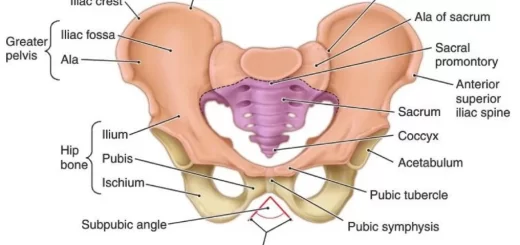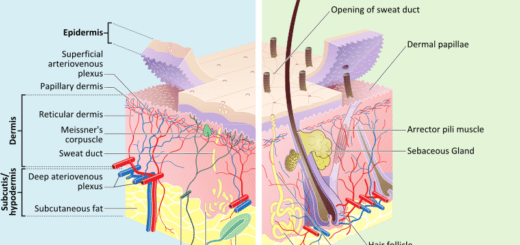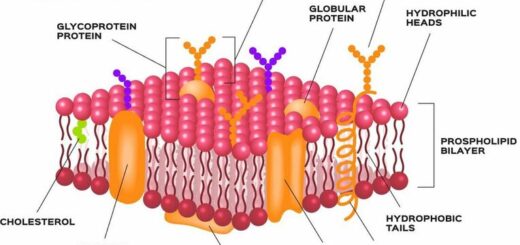Genital system diseases, Structure of ovum and sperm, Fertilization and embryo formation
Surgical tools must be sterilized during labour to protect the mother from infection with some diseases such as puerperal sepsis. Smoking is harmful to reproductive health because it causes the death of embryos and newly born babies and leads to an increase in the deformation rate in embryos.
Ovum and sperm in human
The body of a living organism consists of cells, each celt contains a nucleus that contains the complete number of chromosomes (46 chromosomes) of the species. Chromosomes (genetic material) carry genes, which are responsible for the hereditary traits of the organism. The ovum and sperm differ from any other body cells in the number of chromosomes in the nucleus, where the nucleus of a sperm or an ovum contains only half the number of chromosomes (23 chromosomes).
Structure of the ovum (female gamete)
It is large in size (as sesame seed size) due to the storage of nutrient materials. It is not a mobile cell (it is a static cell). It is a spherical cell. It consists of:
- The nucleus: that contains one-half of the genetic material (23 chromosomes).
- The cytoplasm: that contains stored food and nutrients that are surrounded by a plasma membrane.
- The cellular membrane: an intact membrane that surrounds (coats) the cell from outside.
Structure of the sperm (male gamete)
It is considered very small if it is compared with the ovum. It is a mobile cell.
- The head: that contains one half of the genetic material (23 chromosomes).
- The midpiece: that contains mitochondria which are responsible for energy production needed for sperms movement.
- The tail: thin and long and it is responsible for the movement of the sperm till reaches the ovum.
In human:
- Body cell contains a nucleus that contains the complete number of chromosomes (46 chromosomes).
- Gamete (a sperm or an ovum) contains a nucleus that contains half the number of chromosomes (23 chromosomes).
Fertilization and embryo formation in human
Fertilization process is the fusion of the nucleus of the male gamete (sperm) with the nucleus of the female gamete (ovum) to form the zygote (fertilized ovum).
How does the fertilization process take place?
- The female produces only one ripe ovum on the 14th day of the beginning of the menstrual cycle.
- During mating, the male secretes billions of sperms, which move from the vagina towards the uterus then to the fallopian tube.
- The sperms rush the ovum at the beginning of the fallopian tube.
- The head of the sperm secretes enzymes to dissolve the cellular membrane of the ovum and facilitate its penetration inside the ovum. One sperm only can penetrate the cellular membrane of the ovum.
- After the penetration of the sperm, the ovum surrounds itself with a membrane that prevents the penetration of any other sperm.
- Fertilization occurs by the fusion of the nucleus of sperm (which contains 23 chromosomes) with the nucleus of the ovum (which contains 23 chromosomes) to form the zygote (fertilized ovum), which contains a nucleus with 46 chromosomes (23 pairs of chromosomes).
- The zygote transfers to the uterus to be implanted in its lining.
- The zygote divides many successive divisions into many cells that differentiate and continue to grow forming the embryo (fetus).
The pregnancy period is the period between the fertilization process and delivery which extends for about 9 months. The newborn baby will carry the genetic traits of his parents [as his cells contain 23 chromosomes coming from his mother (ovum) and 23 chromosomes coming from his father (sperm)].
The ovum surrounds itself with a coat after the penetration of sperm inside it to prevent the penetration of any other sperm. The nucleus of a male sexual cell contains one-half of the genetic (hereditary) substance because, during fertilization, it combines with the ovum (egg cell), which contains one-half of the hereditary substance to form the zygote, which contains the complete hereditary substance of the species.
If the fallopian tubes are ligated. The sperm doesn’t reach the ovum, therefore the fertilization (pregnancy) doesn’t occur. So, Fallopian tubes ligation surgically is considered as one of the means of birth control.
The testes of the adult human male produce about 2 billion sperms per day. The lifetime of a single sperm inside the female vagina ranges from 2 to 6 hours, this period can extend to reach up to 3 days if the sperm managed to break through the cervix and enters the uterus where it feeds on the uterine secretions.
In case of failure in fertilization, the endometrium falls down and the blood capillaries detach causing blood to flow out of the vagina for 4 to 5 days in a process known as menstruation.
Plant gametes and human gametes
Plant gametes
- Small in size.
- produced in large numbers.
- mobile.
- each one of them contains half the number of chromosomes that are found in a male (father) body cells.
Human gametes
- large in size because it stores nutrients.
- produced in few numbers.
- not mobile (static).
- each one of them contains half the number of chromosomes that are found in a female (mother) body cell.
Genital system diseases
Diseases of the genital system in males and females are classified into two types, which are:
- Diseases don’t arise from sexual contact with a sick person or a carrier of a sexually transmitted disease. Examples: Uterine cancer, prostate cancer, and puerperal sepsis (childbed fever).
- Diseases arise from sexual contact (sexually transmitted diseases “STDs”) with a sick person or a carrier of a sexually transmitted disease. Examples: Gonorrhea, syphilis, and AIDS.
The incubation period of the disease is the period between the beginning of infection and the appearance of symptoms of the disease. A person who carries a disease: a person who carries the microbe that causes the disease without showing symptoms of the disease.
Puerperal sepsis (fever)
The microbe, that causes the disease: Spherical-shaped bacteria.
Methods of infection:
- By droplets from a person infected with bacteria and suffering from throat infection or tonsillitis to a vagina of a recently laboured mother.
- An infected wound during labour.
Incubation period: From one to four days.
Symptoms:
- High elevation in body temperature.
- Chills.
- Pallor (face paling).
- Severe acute pain in the lower abdomen.
- Bad-smelling secretions from the uterus.
Means of protection (prophylaxis):
- Sterilizing the surgical tools during labour (delivery).
- Wearing masks during labour (delivery).
- Preventing visits of persons, who suffer from respiratory diseases to the mother after delivery.
- The mother should be kept warm and avoid exposure to cold air currents to protect her from throat infection or tonsillitis which may cause the infection with puerperal sepsis (fever).
The bacteria causing puerperal sepsis can be transferred to the patient by her own throat secretions, that is why a pregnant woman suffering any respiratory disease should be treated first before delivery especially in the last two months to avoid autoinfection.
Syphilis
The microbe, that causes the disease: Spiral-shaped bacteria.
Methods of infection:
- Sexual contact with an infected person.
- From a pregnant woman to her fetus (through the umbilical cord or during the delivery).
Incubation period: From two to three weeks.
Symptoms:
- Appearance of painless hard ulcer on the head of the penis (in male) and in the vagina and the upper part of the cervix (in female).
- Appearance of dark brass coloured rashes on the back and hands of the patient.
Means of protection (prophylaxis):
- Preventing sexual contact with an infected person (preventing illegal contacts).
- Induce abortion of the infected pregnant woman.
Complications:
If the patient is not treated as soon as the appearance of symptoms, this leads to:
- The appearance of tumors in different body parts like the liver, bones, and parts of the genital system.
- The brain may also be damaged and the patient will die.
Treatment: Syphilis can be treated in all symptoms stages.
The effect of smoking and addiction on the genital system
The studies showed that there are many bad effects of smoking on the reproductive health of males and females:
- In males: Decreases the formation of male sex hormones.
- In females:
- Decreases the formation of female sex hormones.
- Leads to an increase in the deformation rate in the embryos.
- Leads to the death of the embryos and newly born babies.
Healthy toilet seat cover
A plastic medical cover in the form of an elliptical plastic frame sold in pharmacies is to be used in public toilets to avoid infection by some skin and genital diseases.
Testis functions, sperms production, Factors affecting spermatogenesis, Structure of Epididymis
Reproduction in Human being, Structure of Male genital system and sperm
Productive organs, Germ cells, Fertilization, Stages of cleavage, Implantation and Decidua
Reproduction, Types of sexual reproduction (Conjugation, Reproduction by sexual gametes)
Structure of Female genital system & ovum, Oogenesis stages and Menstrual cycle
Fertilization process, Pregnancy and the stages of embryonic development



